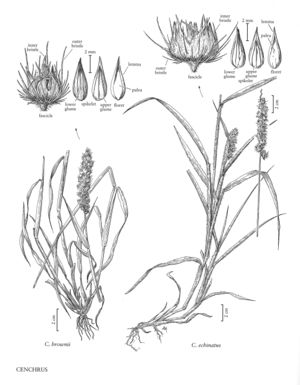Cenchrus echinatus
Plants annual. Culms 20-100 cm, ascending from a geniculate base. Sheaths from shorter than to equaling the internodes, compressed; ligules 0.7-1.7 mm; blades 4-18(35) cm long, 2-10(14.2) mm wide, adaxial surfaces sparsely pilose, hairs papillose-based. Panicles 2.5-12 cm; rachis internodes 2-4 mm; fascicles 5-10 mm long, 3.5-6(6.3) mm wide, imbricate; outer bristles 10-20, terete, the majority no more than 1/2 as long as the inner bristles; inner bristles 2-5 mm long, 0.6-1.5 mm wide, flattened, not grooved, mostly erect, fused for at least 1/2 their length into a globose cupule, sometimes interlocking at maturity, shortly pubescent, often purple at maturity. Spikelets 2-3(4) per fascicle, 4.8-7 mm. Lower glumes 1.3-3.4 mm; upper glumes 3.8-5.7 mm, 3-7-veined; lower lemmas 4.5-6.5 mm; upper florets 4.7-7 mm; anthers 0.8-2.4 mm. Caryopses ovoid, 1.2-3.2 mm long, 1.3-2.2 mm wide. 2n = (34), 68.
Distribution
Md., D.C, Miss., Puerto Rico, Okla., Tex., La., Virgin Islands, Calif., Ala., N.C., S.C., Va., Pacific Islands (Hawaii), Ga., Ariz., Fla., N.Mex.
Discussion
Cenchrus echinatus grows in disturbed areas throughout the coastal plain and piedmont of the southern United States, Mexico, Central and South America, and, as an unwelcome introduction, elsewhere.
Selected References
None.
